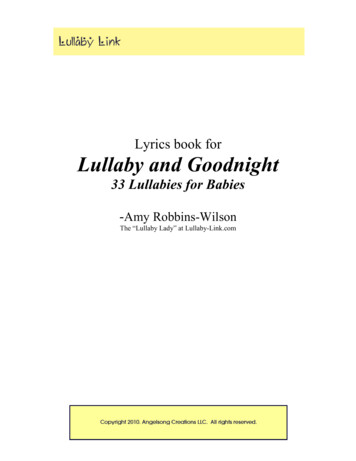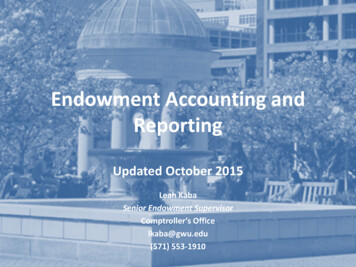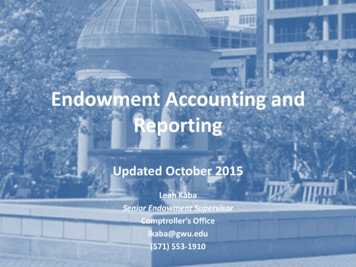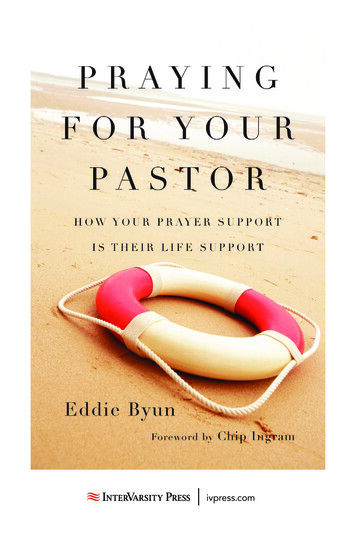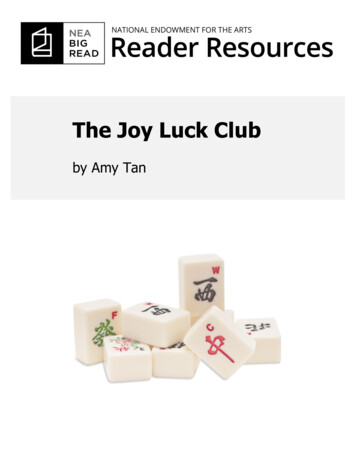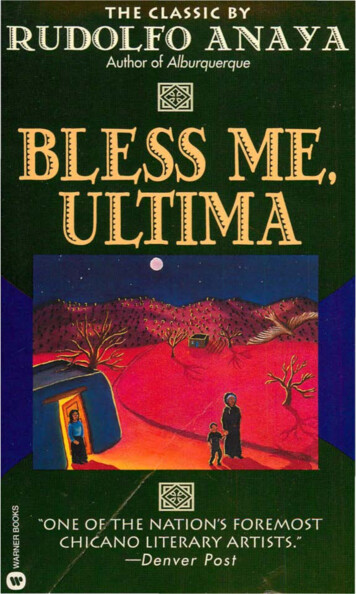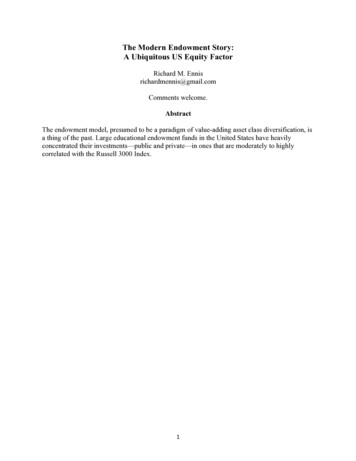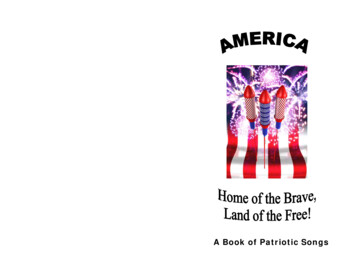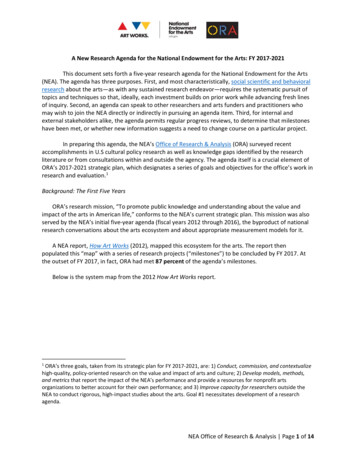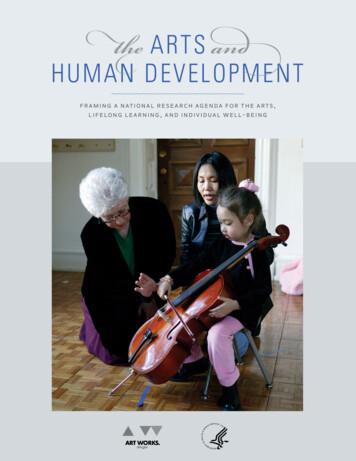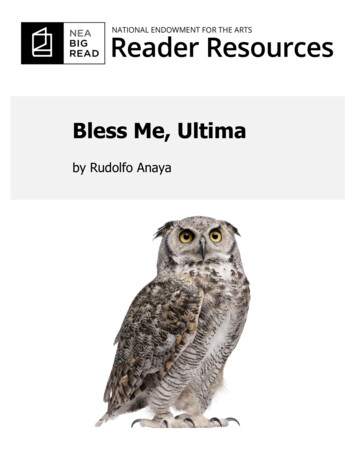
Transcription
Bless Me, Ultimaby Rudolfo Anaya1
Table of ContentsBless Me, UltimaAbout the Book. 3About the Author . 6Historical and Literary Context . 8Other Works/Adaptations . 10Discussion Questions. 12Additional Resources . 13“A novel is notwritten to explain aculture, it createsits own.”Credits . 14PrefaceRudolfo Anaya's Bless Me, Ultima is about pride andassimilation, faith and doubt. The summer before AntonioJuan Márez y Luna turns seven, an old woman with healingpowers comes to live with his family. There is somethingmagical and mystical about Anaya's coming-of-age story inpost-World War II New Mexico. The novel presents a worldwhere everyday life is still full of dreams, legends, prayers,and folkways.What is the NEA Big Read?A program of the National Endowment for the Arts, NEA BigRead broadens our understanding of our world, ourcommunities, and ourselves through the joy of sharing a goodbook. Managed by Arts Midwest, this initiative offers grants tosupport innovative community reading programs designedaround a single book.A great book combines enrichment with enchantment. Itawakens our imagination and enlarges our humanity. It canoffer harrowing insights that somehow console and comfortus. Whether you’re a regular reader already or making up forlost time, thank you for joining the NEA Big Read.NEA Big ReadThe National Endowment for the Arts2
About the BookIntroduction to theBookThe summer before AntonioJuan Márez y Luna turns sevenyears old, an old woman comesto live with his family inGuadalupe, New Mexico. Thiswoman—called La Grande orUltima—is a curandera, atraditional healer feared bymany and mysterious to all.With her knowledge ofmedicinal plants and adorationfor the llano (open plains), sheuses her magic to aid the community.Because she served as his midwife, Ultima has a specialconnection to Antonio. As she teaches him, their bonddeepens. Antonio witnesses several tragic events thatprofoundly shake his understanding of his history and hisfuture. After the murder of Lupito, a soldier recently returnedfrom World War II, Antonio begins to consider sin, death, andthe afterlife in earnest.Among the many conflicts Antonio seeks to resolve, thetension between his parents ranks foremost. A devoutCatholic, María Luna Márez is the daughter of farmers, andshe desperately wants Antonio to become a priest. But hisfather, Gabriel Márez, is a former vaquero, or cowboy, whosewandering spirit has not settled despite marriage and sixchildren. Gabriel's deepest dream has not come true—tomove his family to California's vineyard country.Antonio's dreams often foreshadow the future and feature histhree older brothers, just demobilized from World War II.These surreal dreams also reflect his existential questions:Why is there evil in the world? Why does God sometimesseem to punish the good? Where will I go after death? Howcan I know the truth? Believing that his first Communion willanswer these questions, Antonio studies his catechism andproves an able scholar. Through his dreams and hischallenges—including a mob beating from his schoolmates,the death of a close friend, and his brothers' waywardness—Ultima and her owl remain a watchful, benevolent presence.Bless Me, Ultima is a coming-of-age novel about a youngboy's loss of innocence and approach to maturity. But it alsodeals with tradition and education, faith and doubt, and goodand evil. And if Antonio doesn't find an absolute truth in hissearch, he still comes to believe with his father that"sometimes it takes a lifetime to acquire understanding,NEA Big ReadThe National Endowment for the Artsbecause in the end understanding simply means having asympathy for people."Major Characters in the BookAntonio Juan Márez y LunaThe novel's narrator is an imaginative boy about to turnseven years old. Torn between the Mexican-Catholic heritageand the daily miracles of the natural world, he struggles togain maturity and reconcile all the different blessingsenvisioned for him.Antonio's FamilyGabriel MárezAntonio's father is a former vaquero (cowboy) who dreams ofmoving his family to California.María Luna MárezAntonio's mother is a devout Catholic from a family of farmerswho wants her youngest son, Antonio, to bring honor to thefamily by becoming a priest.León, Eugene, and AndrewAntonio's older brothers have been fighting in World War II.Their return to New Mexico renews Gabriel's dream of a newlife.Antonio's CircleUltimaAlso known as La Grande, the elderly curandera (healer) joinsthe Márez family during her final days. Many in the townbelieve she is a bruja (witch), but she uses her herbal curesfor good.Samuel and CicoAlthough they are only two years older than Antonio, Samueland Cico serve as wise mentors. Samuel tells Antonio thelegend of the Golden Carp the day Antonio finishes firstgrade; Cico takes Antonio to see the magical fish the nextsummer.Horse, Bones, Red, the Vitamin Kid, and AbelThis gang comprises the boys with whom Antonio plays,fights, and ultimately falls out.TenorioThe villain of the novel blames Ultima for the deaths of histwo young daughters. When he vows revenge and attemptsto kill Ultima, Ultima's owl blinds him in one eye.NarcisoThe town drunk and a gifted gardener, he bravely tries tostop Tenorio from murdering Ultima. After Antonio witnessesTenorio's triumph over Narciso under the juniper tree,Antonio's doubts about God deepen.3
How Bless Me, Ultima Came to BeWritten"When I started writing Bless Me, Ultima, I was writingAntonio's story. This boy grows up in a small town, like myhometown, and deals with things that I did—fishing, school,church, and listening to the stories of the people from thecommunity. One night when I was writing late at night,Ultima appeared to me—let me put it that way. She stood atthe door and she asked me what I was doing, and I said Iwas writing a story. And she said that she had to be in thestory. And when I asked her name she said, 'Ultima.' Andthat's when the novel came alive."—Excerpted from Rudolfo Anaya's interview with Dan StoneMiracles and Magic in Bless Me,UltimaNo one in Bless Me, Ultima doubts the existence of mysteryand magic. Miracles, signs, and symbols form a rich part ofthe New Mexican Catholic culture of Anaya's world, a uniquesetting where, for four-hundred years, Catholicism has thrivedalongside Indian Pueblo religions. Much of Antonio's strugglestems from his desire to understand the "correct" source ofthese miracles: the Catholic church, or the curandera.Catholicism offers Antonio a prescribed way of seeing theworld. He diligently learns his Catechism, believing thatrevelation will come once the body of Christ enters himduring his first Communion (Eucharist). He loves the Virgin ofGuadalupe—the patron saint of his small New Mexican town—because she represents forgiveness. A devout Catholicwoman, Antonio's mother María pushes him toward thepriesthood.Ultima never contradicts María, but her ways as a traditionalhealer are different. As Antonio says, "Ultima was acurandera, a woman who knew the herbs and remedies ofthe ancients, a miracle-worker who could heal the sick. Andbecause a curandera had this power she was misunderstoodand often suspected of practicing witchcraft herself."These two perspectives—the church and the curandera—areoften in conflict in the novel. Catholicism praises the VirginMary, yet she is mocked in Antonio's school Christmas play.The town denigrates Ultima as a bruja (witch), but when thepriest cannot heal, some townspeople beg her to use herpower.Ultima tells Antonio not what to believe, but how to makechoices. Like his father, she wants Antonio to think forhimself. By the end of the novel, as Rudolfo Anaya has said,NEA Big ReadThe National Endowment for the Arts"Antonio looks into nature deep enough to see that God is innature, not just the church."Legends in Bless Me, UltimaThe Weeping WomanThe origin of the legend of La Llorona (the Weeping Woman)has been part of Southwestern culture since the days of theconquistadors. Tales vary, but all report that this beautiful,frightening spirit—with long black hair and a white gown—belongs to a cursed mother searching rivers and lakes for herchildren, whom she has drowned. Parents have used thisstory to teach their children, telling them the merciless LaLlorona would drag them to a watery grave if they stay outlate at night. In Bless Me, Ultima, Antonio has a terriblenightmare: "It is la llorona, my brothers cried in fear, the oldwitch who cries along the river banks and seeks the blood ofboys and men to drink!"The Legend of the Golden CarpAnaya created this story, which draws from Christian, Aztec,and Pueblo mythology. The young Antonio first hears aboutthe carp from his friends Samuel and Cico. Similar to the OldTestament's Noah and the flood, the tale warns that unlessthe people stop sinning, the carp will cause a flood to purgetheir evil. Antonio believes the story, but he cannot reconcileit with his Catholicism. After first hearing it, he says that "theroots of everything I had ever believed in seemed shaken."Later, when he sees the carp, he is dazzled by its beauty andwonders if a new religion can blend both the Golden Carp andCatholicism.Herbal Remedies in Bless Me, Ultima"For Ultima, even the plants had a spirit."JuniperA small shrub that grows 4-6 feet high in the Southwest,juniper is used to cure headaches, influenza, nausea, andspider bites. Indians also burned juniper wood for feastingand ceremonial fires."Place many juniper branches on the platform. Have Antoniocut them, he understands the power in the tree."Yerba del mansoManso can be translated to mean calm or quiet. This herb cancure burns, colic in babies, and even rheumatism."Of all the plants we gathered none was endowed with somuch magic as the yerba del manso."OreganoThis herb is also used to heal sore throats and bronchitis.4
"We gathered plenty because this was not only a cure forcoughs and fever but a spice my mother used for beans andmeat."OsháSometimes regarded as a good-luck charm, this herb growsbest in the mountains of New Mexico and Colorado. Alongwith its healing power, it can keep poisonous snakes away."It is like la yerba del manso, a cure for everything."NEA Big ReadThe National Endowment for the Arts5
About the AuthorRudolfo Anaya (b. 1937)Rudolfo Anaya was born inthe small village of Pastura,near Santa Rosa, New Mexico,to a farmgirl mother and acowboy father. The curanderawho presided at his birth setout tools of both family tradesnear the newborn-only to seehim reach for a paper andpencil instead.To judge from his early years,one might have expected himto crawl toward a sportinggoods store. As a boy AnayaRudolfo Anaya, 1992hunted and fished and swam(Copyright Marion Ettlinger)the Pecos River. Later, afterthe family left the countrysidefor Albuquerque, he gravitated toward baseball and football.At sixteen, while roughhousing around an irrigation channelwith friends, Anaya dove in and hit the bottom. Years ofarduous rehabilitation and bedridden reading would passbefore he regained a full movement in his neck.Anaya discovered a different kind of movement during hisyears at the University of New Mexico. El Movimiento, theChicano Civil Rights Movement of the 1960s, encouragedAnaya's dream of writing books that would explore hiscultural heritage.After graduating with his BA and MA, he taught at middleschools, high schools, and universities while writing at night.In 1966, he married Patricia Lawless, who shared his passionfor books and storytelling.After more than seven years of writing and rewriting hisnovel, Anaya submitted his first manuscript, Bless Me, Ultima,to the small Berkeley press, Quinto Sol. A 1,000 prizeaccompanied the novel's printing, and the mainstream NewYork publisher Warner Books later acquired its rights. Sinceits publication in 1972, the novel has become part of highschool English and university Chicano literature classes.Writer Tony Hillerman has praised Anaya as the "godfatherand guru of Chicano literature."Dan Stone: Did you grow up in a bilingual household likeAntonio Márez in Bless Me, Ultima?Rudolfo Anaya: My parents spoke only Spanish. My dadworked for big ranchers and he could buy and sell cattle,which meant he could get along in English. But at home itwas a complete Spanish-speaking household. By the time Iwent to school when I was six or seven, I didn't knowEnglish, I only knew Spanish. When I look back, I think thatwe must have had wonderful teachers who, instead ofalienating us, allowed us to make a transition into thatEnglish-speaking world.DS: Would you describe some of the autobiographicalaspects in your novel?RA: Bless Me, Ultima is autobiographical in the sense that Iuse my hometown, the Pecos River, Highway 66, the church,the school, the little villages and ranches around the town.My parents were very much like Antonio's parents. My mothergrew up in a farming family in Porta de Luna. My father grewup on the llano as a vaquero, as a cowboy, so as a child, Isaw the tensions that a conflicting way of life created.DS: It's a potent internal conflict.RA: Antonio's ambivalence also has to deal with the conflictthat the parents seem to impose on him. The mother says,"Our way of life is changing. You've got to have aneducation." And one way to get that education would be tobecome a priest. And the father says, "I'm not too religious, Iwant him to be like me, a cowboy, a vaquero." And that wayof life also was dying in the 1940s and '50s, so Antonio hasthat big internal conflict that has to do with family roots.DS: When did you become interested in reading and writing,and how did that develop as you moved on to the university?RA: Becoming a writer is an evolutionary process. I had hada very serious spinal cord injury accident when I was in highschool, and that also figures a great deal into my life.Somehow that time of being in the hospital and dealing withrecovery and seeing other kids my age really suffering a lot,seeing death, and then coming out of that experience, wasvery important and informative. That's one of the experiencesthat told me that I have to write, to record not only whathappened to me, but what happened to people around me.An Interview with Rudolfo AnayaDS: Was it difficult to develop your own voice and breakaway from what you had been taught at the University ofNew Mexico?On January 4, 2007, Dan Stone of the National Endowmentfor the Arts, interviewed Rudolfo Anaya at his home inAlbuquerque, New Mexico. An excerpt from their conversationfollows.RA: Yes. I started at the university in 1958 and at that timethere were very few Chicano students on campus, and veryfew in the English department studying English literature. So,I was very much alone for a long period of time. It was aNEA Big ReadThe National Endowment for the Arts6
struggle. My companion was a dictionary, and I spent hoursand hours in the library reading and doing research. And Ihad some very good professors. There were not any Chicanoprofessors, but there were very good teachers. They wereguides, and they helped me along.DS: Did you know a curandera when you were young?RA: When I was growing up, the curanderas were peoplewho helped when there was a baby to be delivered, or maybesomebody broke an arm and fell off a horse, or couldn't getto a doctor. In Bless Me, Ultima, I took that very real world ofwomen who are healers, or curanderas, but I moved it a littlebit into witchcraft to set up the conflict between good andevil.DS: For whom do you write, and why?RA: I think the answer is, I write because I must. Then thewhole idea of community comes into mind. Yes, I write formy New Mexican community, the Spanish-speaking world, butalso for the entire world. Sometimes I'll be writing and I'llthink of a person, a family member, or sometimes of a critic,and I'll say, "This is for them."NEA Big ReadThe National Endowment for the Arts7
Historical and Literary ContextThe Life and Times of1980sRudolfo Anaya 1986: Immigration Reform and Control Act institutessanctions for hiring the undocumented, strengthensborder patrol enforcement.1930s Anaya travels to China in 1984, and later publisheshis travel journal, A Chicano in China in 1986 1932: Franklin Delano Roosevelt elected U.S. president. 1937: Rudolfo Anaya born October 30 in Pastura, NewMexico.1940s 1941: Japanese forces bomb Pearl Harbor; Americaenters World War II. Anaya's brothers fight in World War II. 1945: Scientists test the atomic bomb in NewMexico, which the U.S. then drops over Japan,ending World War II.1950s 1953: Dwight D. Eisenhower inaugurated U.S.president, cementing a period of economicprosperity. 1953: Anaya becomes temporarily paralyzed after adiving accident.1960s 1966: César Chávez organizes a band of strikingCalifornia fruit pickers, leading to a five-year grapeboycott. Anaya graduates from the University of New Mexicowith a BA in English in 1963, and marries PatriciaLawless in 1966.1970s 1970: Rally in Los Angeles protests high Latinocasualties in Vietnam War; three killed, including LosAngeles Times reporter Ruben Salazar. 1972: Anaya's first novel, Bless Me, Ultima, ispublished. 1979: Anaya receives an NEA Literature Fellowship.NEA Big ReadThe National Endowment for the Arts1990s 1993: César Chávez dies. 1995: Anaya releases Zia Summer, his first SonnyBaca mystery.2000s 2000: Anaya's book-length poem Elegy on the Deathof César Chávez is published. 2001: Anaya receives the National Medal of Arts. 2002: Pope John Paul II canonizes Juan DiegoCuauhtlatoatzin as the first Indian saint of theAmericas. 2010: Anaya's wife, Patricia, dies in January.The Virgin of Guadalupe (PatronSaint of Mexico)Twelve years after Spanish explorers landed on Mexican soil,the miracle of the Virgin of Guadalupe occurred. In 1531, thedark-skinned mother of Jesus appeared several times to apeasant Indian man named Juan Diego, a Catholic convert.She asked to have a church built on the site. After Diego tolda bishop what happened—only to be turned away—a colorfulimage of the Virgin was emblazoned on Diego's cloak tovalidate his story. This miracle led to the conversion of aboutnine million of Mexico's Indians to Catholicism. The Vaticanrecognized this miracle in 1745, and the image now hangsabove the altar in the Basílica de Santa María de Guadalupe inMexico City.Anaya's New MexicoLike his protagonist Antonio Márez in Bless Me, Ultima,Rudolfo Anaya grew up in New Mexico under the shadow ofWorld War II, which his brothers fought overseas. As a youngboy in 1945, he would not have realized that, less than aday's ride away on horseback, government scientists in LosAlamos, New Mexico, had manufactured the atomic bombthat would bring the war in the Pacific to its horrific end.8
Rural New Mexico in the mid-twentieth century had long beena land of Mexican and Native American tradition both luredby, and resistant to, civilization's advances. Hopi, Navajo, andPueblo Indians had foraged and farmed there for centuries.When the Spanish arrived in 1540, they were newcomers. Butthe religion they believed, the laws they imposed, and thelanguage they brought all took root.The Rio Grande corridor is the bedrock of the Pueblo, Navajo,and Apache Indians, a spiritual setting that informs Anaya'sfiction. As Anaya has said, "Into that came the Spaniards andthe Mexicans with the Catholic religion; later, Anglo Americacomes in. So you have a fascinating place where thesecultures are mixing, learning from each other, and quite oftenin conflict." The body of Spanish and Mexican folklore, calledcuentos, passed orally from generation to generation,contains the basis of New Mexican values and beliefs.Through Ultima and Antonio, Anaya has created his own storythat is as much old as new.NEA Big ReadThe National Endowment for the Arts9
Other Works/AdaptationsAnaya and His Other WorksRudolfo Anaya's books since Bless Me, Ultima (1972) fall intoroughly three approximate categories: the novels, stories,essays, poetry, and plays he writes for his grandchildren; andthe anthologies that he's edited out of a sense ofresponsibility to his peers and inheritors. After the success ofhis first novel, Anaya wrote Heart of Aztlan (1976), thepersonal and political novel of a boy whose family movesfrom the New Mexico countryside to the barrio. Rounding outhis semi-autobiographical trilogy is the novel Tortuga (1979),which reimagines the months Anaya spent in a hospitalrecuperating from a near-fatal teenage diving accident. Somecritics, including Anaya himself, consider Tortuga his bestbook.Yet Anaya was hardly finished. In 2006, he published twonew books: a collection of short fiction, The Man Who CouldFly and Other Stories, and Curse of the ChupaCabra, his firstyoung-adult novel. Pushing seventy, Anaya was happy to beremembered as the groundbreaking author of Bless Me,Ultima, perhaps even happier as the author of a still-growingshelf of books. As an undergraduate at the University of NewMexico in Albuquerque, he had searched the ZimmermanLibrary in vain for a literary tradition to call his own. Today,that same library's Center for Southwest Research hasbecome a mecca for Anaya scholars, housing a wealth of hisfirst editions, international translations, and manuscripts.With the trilogy behind him, Anaya turned his hand to severalother genres. A Chicano in China (1986) narrates Anaya'stravels in the Far East. The Legend of La Llorona (1984) andLord of the Dawn: The Legend of Quetzalcóatl (1987) retellthe myths of the "weeping woman" of the Southwest and thewinged dragon of Mexico. The Farolitos of Christmas: A NewMexico Christmas Story (1987) was Anaya's first children'sstory, preserving a vignette he invented for hisgranddaughter.Just when Anaya might have settled prematurely into the roleof Chicano elder statesman, in 1992 he published the novelAlburquerque, which became an important transitional bookfor him. His first fully realized, adult story of the urban West,Alburquerque reclaimed the original spelling of his adoptedhometown for a story that combined many of the forms hehad already used and added an important new one: detectivefiction.The book won the prestigious PEN/West Award, and pavedthe way for Anaya's quartet of Sonny Baca mysteries.Grouped around the seasons that governed Anaya's childhoodon his family's farm, these novels of a shamus graduallyturning shaman—Zia Summer (1995), Rio Grande Fall (1996),Shaman Winter (1999), and Jemez Spring (2005)—broughtAnaya a largely new audience.In 2000, Anaya undertook another book-length poem, thisone destined for young readers. Elegy on the Death of CésarChávez (2000) commemorated the travails and triumphs ofthe great United Farm Workers founder. The Chicanomovement in which both men had played an important partwas passing into history, and Anaya took pains to ensure thatChávez's accomplishments were not forgotten by the youngergeneration whose relative freedom he had helped to makepossible. The struggle remained far from over, so Anaya'selegy struck a balance between honoring his own aginggeneration and rousing the next one.NEA Big ReadThe National Endowment for the Arts10
Selected Works by AnayaFiction Bless Me, Ultima, 1972 Heart of Aztlan, 1976 Tortuga, 1979 The Legend of La Llorona, 1984 The Adventures of Juan Chicaspatas, 1985 Lord of the Dawn: The Legend of Quetzalcóatl, 1987 Alburquerque, 1992 The Man Who Could Fly and Other Stories, 2006 ChupaCabra and the Roswell UFO, 2008 The Old Man's Love Story, 2013The Sonny Baca mysteries Zia Summer, 1995 Rio Grande Fall, 1996 Shaman Winter, 1999 Jemez Spring, 2005Books for Children The Farolitos of Christmas: A New Mexico ChristmasStory, 1987 Maya's Children: The Story of La Llorona, 1997 My Land Sings: Stories from the Río Grande, 1999 The First Tortilla: A Bilingual Story, 2007 Juan and the Jackalope, 2009Nonfiction A Chicano in China, 1986 Voices: An Anthology of Nuevo Mexicano Writers,1987, editor Flow of the River, 2nd ed., 1992 Elegy on the Death of César Chávez, 2000NEA Big ReadThe National Endowment for the Arts11
Discussion Questions1.Bless Me, Ultima is a coming-of-age story thatchronicles several rites of passage for Antonio. Whichaspects of his development are universal, and whichare particular to his Hispanic Catholic culture?2.Why does the Márez family ask Ultima to live withthem? Why does she think Antonio is special?Despite the conflicts between his parents and theskepticism of their neighbors, why is the family'sview of Ultima the one thing upon which they canagree?3.The novel's action begins near the close of WorldWar II, before Antonio's three soldier-brothers returnsafely home to New Mexico. How important is thewar to the story?4.What makes Antonio's first day of school so difficult?5.How does Antonio's perception of Ultima differ fromthe opinions of those in his town?6.What do Antonio's dreams reveal about him? How dothey change as he matures?7.The humor in the novel usually comes from momentswhen the boys are playing or fighting together. Whatsignificance is there to the Christmas play, in whichHorse plays the Virgin Mary and Antonio plays ashepherd?8.Often the boys' games lead to violence that parallelsthe adult world. What happens when they forceAntonio to become their priest?9.How does the legend of the Golden Carp resemblethe New Testament story of Jesus Christ, or theMexican story of the Virgin of Guadalupe?10. What happens when Antonio finally takes his longawaited first Communion?11. Antonio witnesses the deaths of several adults andone of his childhood friends. How does the latterdeath, especially, affect his sense of the world?12. At the end of the novel, a radical thought comes toeight-year-old Antonio: Is a new religion possible?What do you think is the answer to his question?13. How would you answer Antonio's final question:"What dream would form to guide my life as a man?"Does he choose the life of a farmer, vaquero, priest,or something else?14. In your experience, does the novel reinforce or revisestereotypes of Hispanic culture?NEA Big ReadThe National Endowment for the Arts12
Additional ResourcesOther Works about Anaya Dick, Bruce, and Silvio Sirias, eds. Conversations withRudolfo Anaya. Jackson: University Press ofMississippi, 1998. Fernández Olmos, Margarite. Rudolfo A. Anaya: ACritical Companion. Westport, CT: Greenwood Press,1999.If you liked Bless Me, Ultima, youmight enjoy: Julia Alvarez's How the Garcia Girls Lost TheirAccents, 1992 Willa Cather's Death Comes for the Archbishop, 1927 Frank Waters's Of Time and Change: A Memoir, 1998If you want to read other Chicanowriters, you might enjoy: Ana Castillo's So Far From God, 1993 Tony Hillerman's Dance Hall of the Dead, 1973 Tomás Rivera's . y no se lo tragó la tierra / . Andthe Earth Did Not Devour Him, 1970 Luis Alberto Urrea's The Hummingbird's Daughter,2005NEA Big ReadThe National Endowment for the Arts13
CreditsWorks CitedAnaya, Rudolfo A. Interview with Dan Stone for NEA BigRead. 4 January 2007.Passages from BLESS ME, ULTIMA; BENDÍCEME, ULTIMA.Copyright 1972 by Rudolfo Anaya in English, 1992 inSpanish. Published by Warner Books in 1994. First publishedby TQS Publications, Berkeley, CA. By permission of theAuthor and Susan Bergholz Literary Services, New York Cityand Lamy, NM. All rights reserved.AcknowledgmentsThe National Endowment for the Arts was established byCongress in 1965 as an independent agency of the federalgovernment. To date, the NEA has awarded more than 5billion to support artistic excellence, creativity, and innovationfor the benefit of individuals and communities. The NEAextends its work through partnerships with state artsagencies, local leaders, other federal agencies, and thephilanthropic sector.Writers: Erika Koss for the National Endowment for the Arts,with preface by Dana GioiaCover image: "Great Horned Owl, Bubo VirginianusSubarcticus, in front of white background" by Eric Isselee.Shutterstock.Arts Midwest promotes creativity, nurtures cultural leadership,and engages people in meaningful arts experiences, bringingvitality to Midwest communities and enriching people’s lives.Based in Minneapolis, Arts Midwest connects the arts toaudiences throughout the nine-state region of Illinois,Indiana, Iowa, Michigan, Minnesota, North Dakota, Ohio,South Dakota, and Wisconsin. One of six non-profit regionalarts organizations in the United States, Arts Midwest’s historyspans more than 30 years.NEA Big Read Reader Resources are licensed under a Creative CommonsAttribution-NonCommercial-NoDerivatives 4.0 International License. Arts MidwestNEA Big ReadThe National Endowment for the Arts14
where everyday life is still full of dreams, legends, prayers, and folkways. What is the NEA Big Read? A program of the National Endowment for the Arts, NEA Big Read broadens our understanding of our world, our communities, and ourselves through the joy of sharing a good book.
